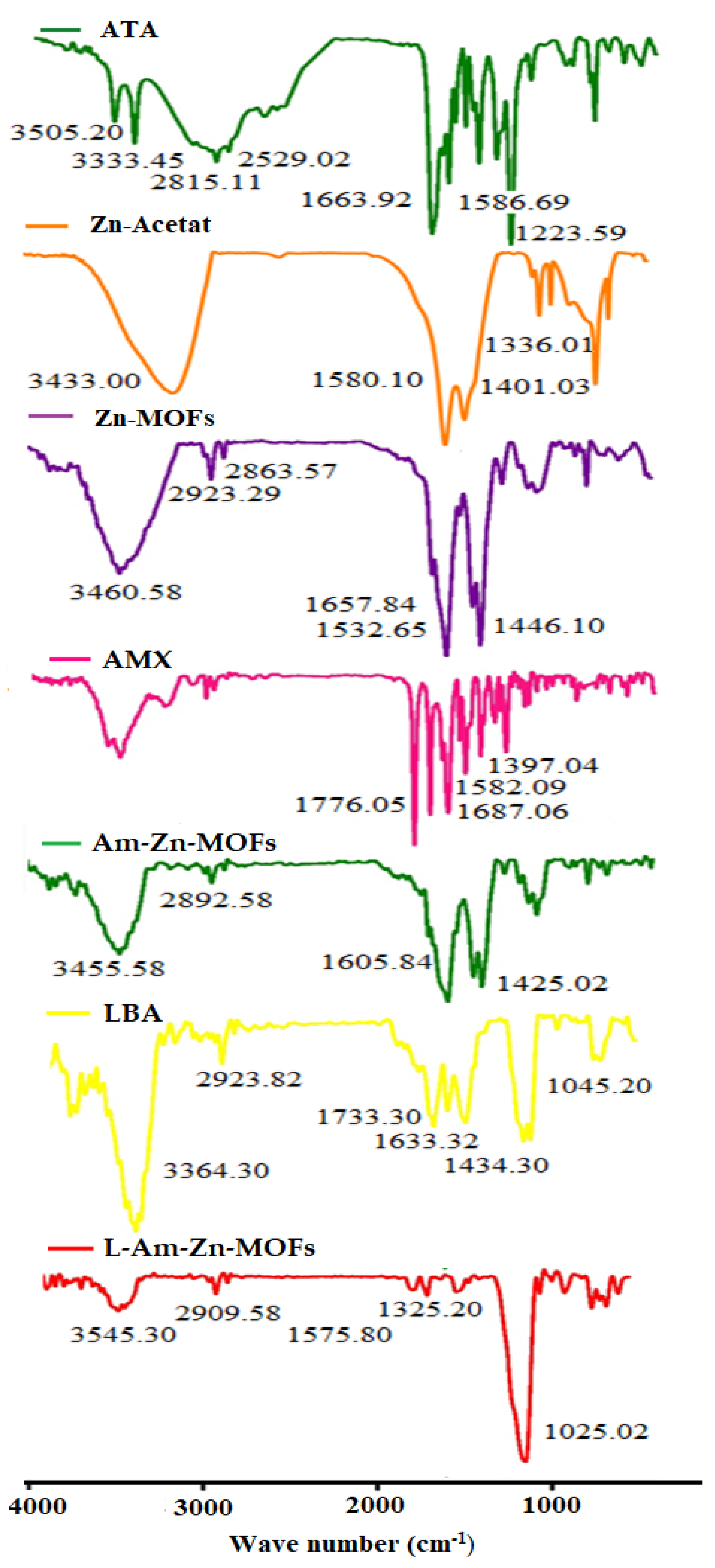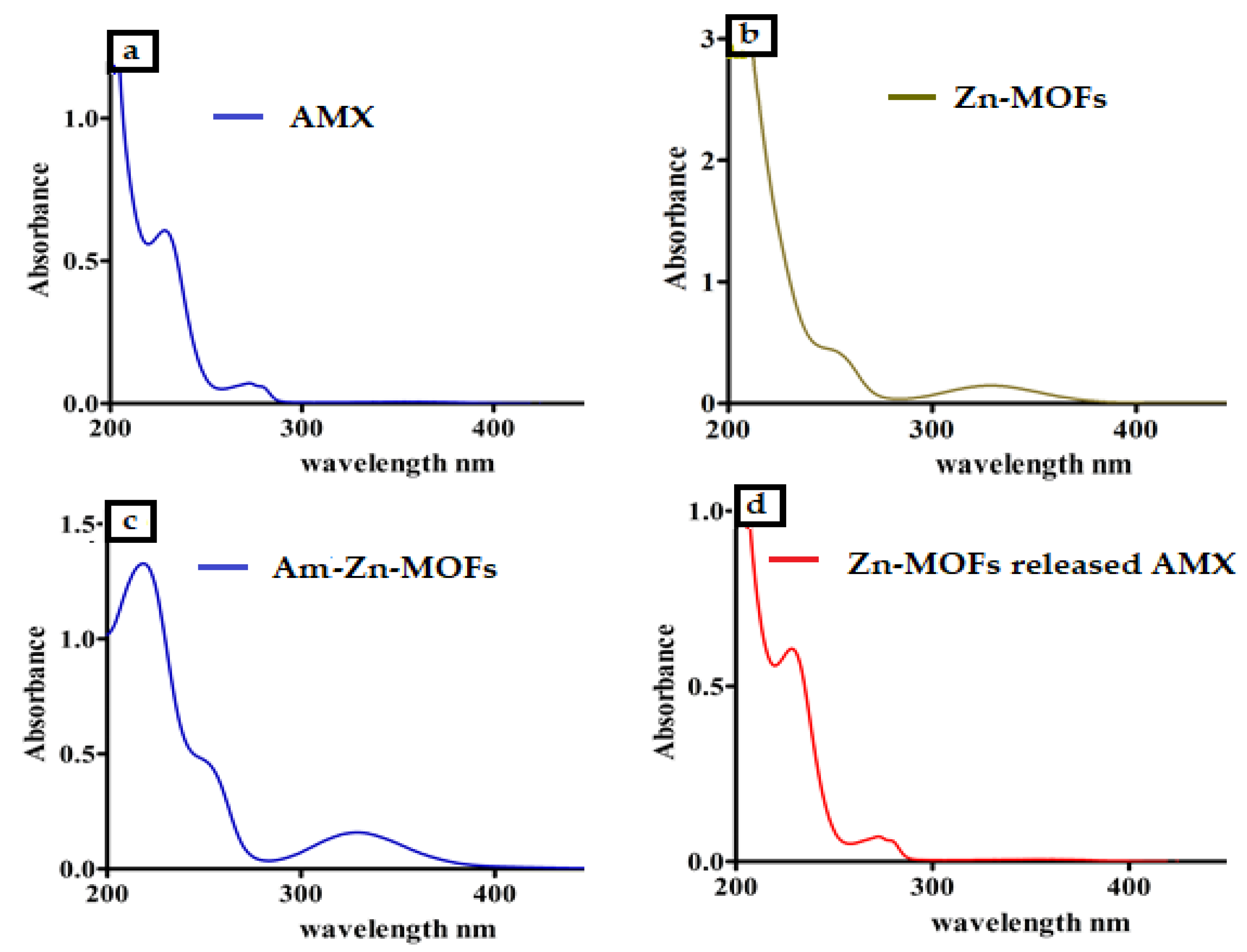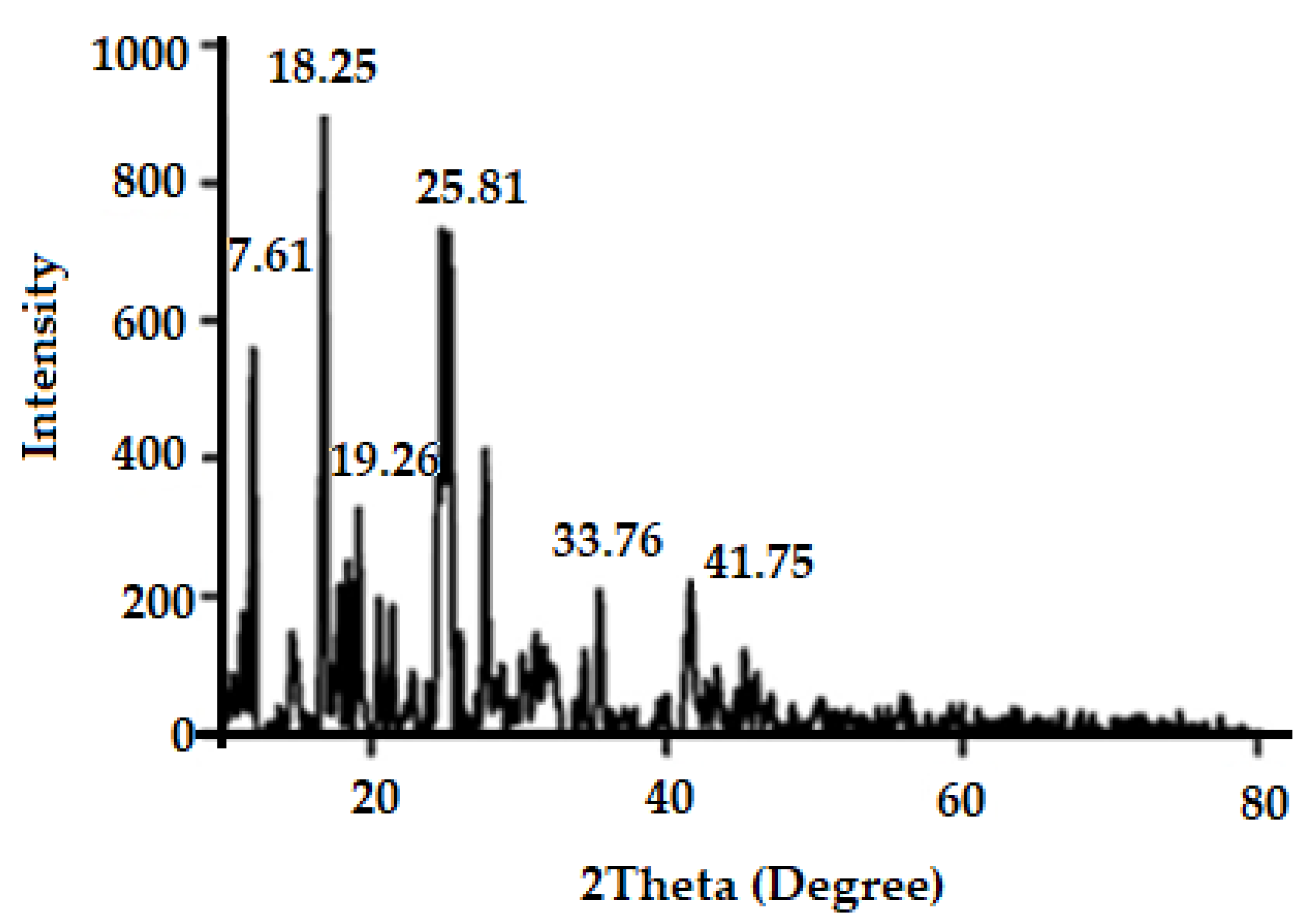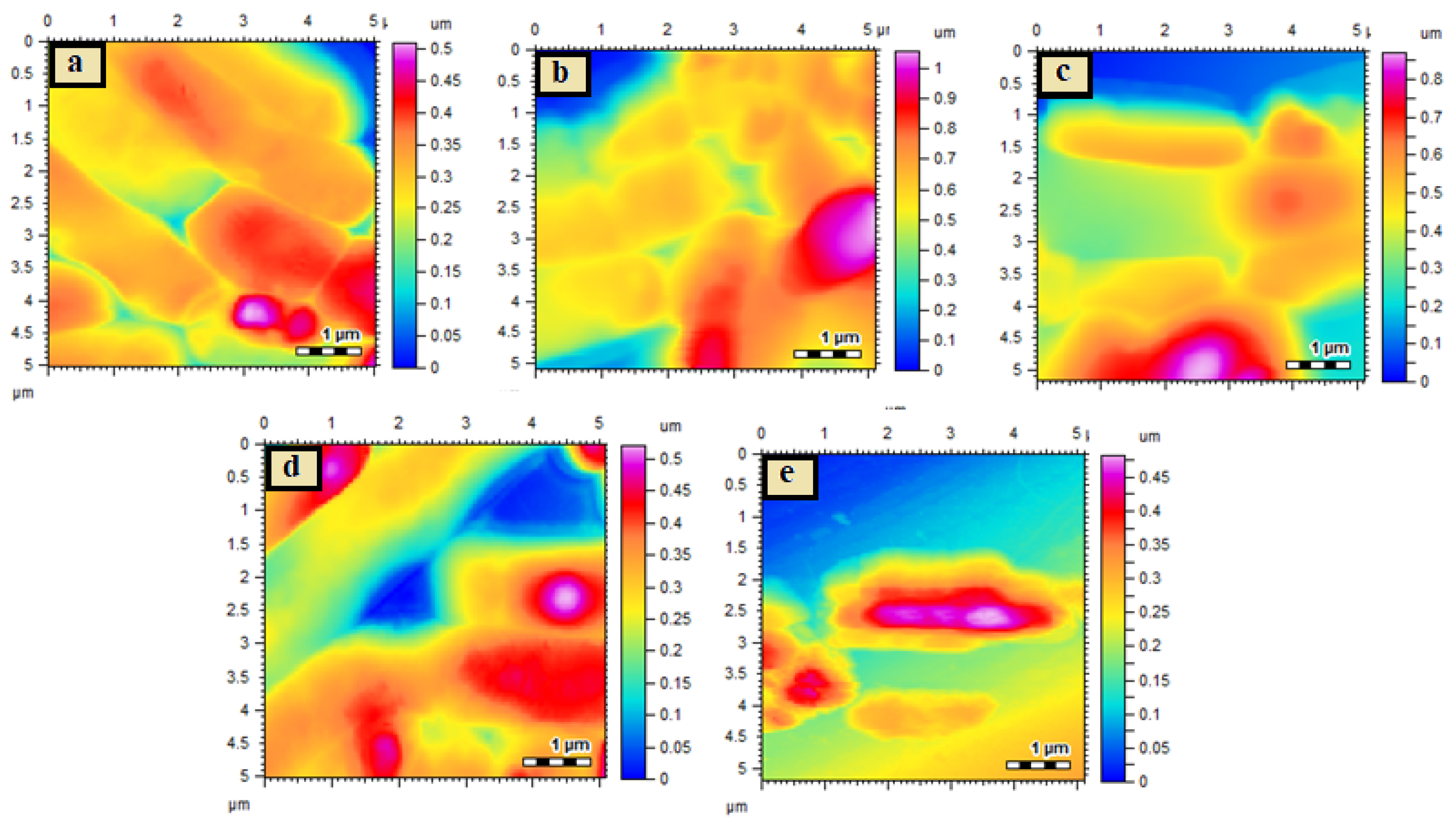Enhanced Antibacterial Potential of Amoxicillin against Helicobacter pylori Mediated by Lactobionic Acid Coated Zn-MOFs
Abstract
1. Introduction
2. Materials and Methods
2.1. Reagents
2.2. Synthesis of Zn-MOFs
2.3. Incorporation of Amoxicillin in Zn-MOFs
2.4. Coating of Lactobionic Acid on Am-Zn-MOFs
2.5. Characterization
2.5.1. FT-IR Analysis
2.5.2. Determination of Size, Polydispersity Index (PDI), Zeta-Potential, and Surface Morphology
2.5.3. Powder XRD
2.6. Antibacterial Assay
2.6.1. Bacterial Strains
2.6.2. Microplate Assay of Minimum Inhibitory Concentration (MIC)
2.6.3. Determination of Minimum Biofilm Inhibitory Concentration (MBIC)
2.6.4. Scanning Electron Microscopy of Biofilm
2.6.5. Morphological Changes Studied by Atomic Force Microscopy
2.7. Statistical Analysis
3. Results and Discussion
3.1. FT-IR and UV Analysis
3.2. Determination of Size, PDI and Zeta-Potential, and Surface Morphology
3.3. Drug Encapsulation Efficiency
3.4. Powder XRD
3.5. Antibacterial Assay
3.5.1. Determination of MIC Value
3.5.2. Determination of MBIC Value
4. Conclusions
Author Contributions
Funding
Data Availability Statement
Acknowledgments
Conflicts of Interest
References
- Wilson, W. Prevention of infective endocarditis: Guidelines from the American heart association: A guideline from the American heart association rheumatic fever, endocarditis, and Kawasaki disease committee, council on cardiovascular disease in the young, and the council on clinical cardiology, council on cardiovascular surgery and anesthesia, and the quality of care and outcomes research interdisciplinary working group. Circulation 2007, 116, 1736–1754. [Google Scholar]
- Akhavan, B.J.; Khanna, N.R.; Vijhani, P. Amoxicillin; StatPearls Publishing: San Francisco, CA, USA, 2020. [Google Scholar]
- Drissi, M. Antibiotic susceptibility and mechanisms of β-lactam resistance among clinical strains of Pseudomonas aeruginosa: First report in Algeria. Med. Mal. Infect. 2008, 38, 187–191. [Google Scholar] [CrossRef]
- Hooi, J.K. Global prevalence of Helicobacter pylori infection: Systematic review and meta-analysis. J. Gastroenterol. 2017, 153, 420–429. [Google Scholar] [CrossRef] [PubMed]
- Hatakeyama, M.; Brzozowski, T. Pathogenesis of Helicobacter pylori infection. Helicobacter 2006, 11, 14–20. [Google Scholar] [CrossRef] [PubMed]
- Matysiak-Budnik, T. Helicobacter pylori and non-malignant diseases. Helicobacter 2006, 11, 27–31. [Google Scholar] [CrossRef] [PubMed]
- Rocha, G.A. STAT 3 polymorphism and Helicobacter pylori CagA strains with higher number of EPIYA-C segments independently increase the risk of gastric cancer. BMC Cancer 2015, 15, 528. [Google Scholar] [CrossRef] [PubMed]
- Amieva, M.R.; El–Omar, E.M. Host-bacterial interactions in Helicobacter pylori infection. J. Gastroenterol. 2008, 134, 306–323. [Google Scholar] [CrossRef] [PubMed]
- Hatakeyama, M.; Higashi, H. Helicobacter pylori CagA: A new paradigm for bacterial carcinogenesis. Cancer Sci. 2005, 96, 835–843. [Google Scholar] [CrossRef] [PubMed]
- Backert, S. Functional analysis of the cag pathogenicity island in Helicobacter pylori isolates from patients with gastritis, peptic ulcer, and gastric cancer. Infect. Immun. 2004, 72, 1043–1056. [Google Scholar] [CrossRef] [PubMed]
- Bae, S.E. The effect of eradication of Helicobacter pylori on gastric cancer prevention in healthy asymptomatic populations. Helicobacter 2018, 23, 12464. [Google Scholar] [CrossRef]
- Hu, Y.; Zhu, Y.; Lu, N.-H. Novel and effective therapeutic regimens for Helicobacter pylori in an era of increasing antibiotic resistance. Front. Cell. Infect. Microbiol. 2017, 7, 168. [Google Scholar] [CrossRef]
- Grande, R. Helicobacter pylori ATCC 43629/NCTC 11639 outer membrane vesicles (OMVs) from biofilm and planktonic phase associated with extracellular DNA (eDNA). Front. Microbiol. 2015, 6, 1369. [Google Scholar] [CrossRef]
- Ronci, M. Identification and characterization of the α-CA in the outer membrane vesicles produced by Helicobacter pylori. J. Enzym. Inhib. Med. Chem. 2019, 34, 189–195. [Google Scholar] [CrossRef]
- Schulze, A. Biofilms by bacterial human pathogens: Clinical relevance-development, composition and regulation-therapeutical strategies. Microb. Cell 2021, 8, 28. [Google Scholar] [CrossRef]
- Flemming, H.-C.; Wuertz, S. Bacteria and archaea on Earth and their abundance in biofilms. Nat. Rev. Microbiol. 2019, 17, 247–260. [Google Scholar] [CrossRef] [PubMed]
- Joo, H.-S.; Otto, M. Molecular basis of in vivo biofilm formation by bacterial pathogens. Chem. Biol. 2012, 19, 1503–1513. [Google Scholar] [CrossRef]
- Hu, D. Surface-adaptive gold nanoparticles with effective adherence and enhanced photothermal ablation of methicillin-resistant Staphylococcus aureus biofilm. ACS Nano 2017, 11, 9330–9339. [Google Scholar] [CrossRef]
- Yao, L. Codeposition of polydopamine and zwitterionic polymer on membrane surface with enhanced stability and antibiofouling property. Langmuir 2018, 35, 1430–1439. [Google Scholar] [CrossRef] [PubMed]
- Kim, H.-S. Raffinose, a plant galactoside, inhibits Pseudomonas aeruginosa biofilm formation via binding to LecA and decreasing cellular cyclic diguanylate levels. Sci. Rep. 2016, 6, 25318. [Google Scholar] [CrossRef]
- Qiu, H. Depriving Bacterial Adhesion-Related Molecule to Inhibit Biofilm Formation Using CeO2-Decorated Metal-Organic Frameworks. Small 2019, 15, e1902522. [Google Scholar] [CrossRef] [PubMed]
- Ghaffar, I. Synthesis of chitosan coated metal organic frameworks (MOFs) for increasing vancomycin bactericidal potentials against resistant S. aureus strain. Mater. Sci. Eng. C 2019, 105, 110111. [Google Scholar] [CrossRef]
- Kaner, D. Timing affects the clinical outcome of adjunctive systemic antibiotic therapy for generalized aggressive periodontitis. J. Periodontol. 2007, 78, 1201–1208. [Google Scholar] [CrossRef]
- Simon-Yarza, T. Nanoparticles of metal-organic frameworks: On the road to in vivo efficacy in biomedicine. Adv. Mater. 2018, 30, 1707365. [Google Scholar] [CrossRef] [PubMed]
- Horcajada, P. Porous metal–organic-framework nanoscale carriers as a potential platform for drug delivery and imaging. Nat. Mater. 2010, 9, 172–178. [Google Scholar] [CrossRef] [PubMed]
- Hartmann, M. Adsorptive separation of isobutene and isobutane on Cu3(BTC)2. Langmuir 2008, 24, 8634–8642. [Google Scholar] [CrossRef] [PubMed]
- Shultz, A.M. A catalytically active, permanently microporous MOF with metalloporphyrin struts. J. Am. Chem. Soc. 2009, 131, 4204–4205. [Google Scholar] [CrossRef]
- Rodrigues, M.O. Modeling, structural, and spectroscopic studies of lanthanide-organic frameworks. J. Phys. Chem. B 2009, 113, 12181–12188. [Google Scholar] [CrossRef] [PubMed]
- Aquino, A. Coordination polymer adsorbent for matrix solid-phase dispersion extraction of pesticides during analysis of dehydrated Hyptis pectinata medicinal plant by GC/MS. Talanta 2010, 83, 631–636. [Google Scholar] [CrossRef]
- Chen, B. Surface interactions and quantum kinetic molecular sieving for H2 and D2 adsorption on a mixed metal− organic framework material. J. Am. Chem. Soc. 2008, 130, 6411–6423. [Google Scholar] [CrossRef]
- Abbasi, A.R.; Morsali, A.A. Dense coating of surface mounted CuBTC metal–organic framework nanostructures on silk fibers, prepared by layer-by-layer method under ultrasound irradiation with antibacterial activity. Ultrason. Sonochem. 2012, 19, 846–852. [Google Scholar] [CrossRef]
- Alavijeh, R.K. Investigation of reasons for metal–organic framework’s antibacterial activities. Polyhedron 2018, 156, 257–278. [Google Scholar] [CrossRef]
- Cai, W. Metal–organic framework-based stimuli-responsive systems for drug delivery. Adv. Sci. 2019, 6, 1801526. [Google Scholar] [CrossRef] [PubMed]
- Shen, M. Antibacterial applications of metal–organic frameworks and their composites. Compr. Rev. Food Sci. Food Saf. 2020, 19, 1397–1419. [Google Scholar] [CrossRef]
- Kambe, T. The physiological, biochemical, and molecular roles of zinc transporters in zinc homeostasis and metabolism. Physiol. Rev. 2015, 95, 749–784. [Google Scholar] [CrossRef]
- Wang, Y.-W. Superior antibacterial activity of zinc oxide/graphene oxide composites originating from high zinc concentration localized around bacteria. ACS Appl. Mater. Interfaces 2014, 6, 2791–2798. [Google Scholar] [CrossRef] [PubMed]
- Zhu, P. Biomedical applications of functionalized ZnO nanomaterials: From biosensors to bioimaging. Adv. Mater. Interfaces 2016, 3, 1500494. [Google Scholar] [CrossRef]
- Barman, A. Review on biocompatibility of ZnO nano particles. In Advancements of Medical Electronics; Gupta, S., Bag, S., Ganguly, K., Sarkar, I., Biswas, P., Eds.; Springer: New York, NY, USA, 2015; pp. 343–352. [Google Scholar]
- Sargazi, G. Fabrication of PVA/ZnO fibrous composite polymer as a novel sorbent for arsenic removal: Design and a systematic study. Polym. Bull. 2019, 76, 5661–5682. [Google Scholar] [CrossRef]
- Zhang, Y.-H. A Zn (II)-based pillar-layered metal–organic framework: Synthesis, structure, and CO2 selective adsorption. Polyhedron 2019, 158, 283–289. [Google Scholar] [CrossRef]
- Restrepo, J. An antibacterial Zn–MOF with hydrazinebenzoate linkers. Eur. J. Inorg. Chem. 2016, 2017, 574–580. [Google Scholar] [CrossRef]
- Alonso, S.; Rendueles, M.; Díaz, M.L. Bio-production of lactobionic acid: Current status, applications and future prospects. Biotechnol. Adv. 2013, 31, 1275–1291. [Google Scholar] [CrossRef]
- Van Dokkum, W. Tolerance of lactobionic acid in man. J. Food Nutr. Res. 1994, 95, 1–22. [Google Scholar]
- Olivieri, M. Experimental evidence of the healing properties of lactobionic acid for ocular surface disease. Cornea 2018, 37, 1058–1063. [Google Scholar] [CrossRef] [PubMed]
- Chen, H.; Zhong, Q. Lactobionic acid enhances the synergistic effect of nisin and thymol against Listeria monocytogenes Scott A in tryptic soy broth and milk. Int. J. Food Microbiol. 2017, 260, 36–41. [Google Scholar] [CrossRef] [PubMed]
- Mukherjee, R.; Yun, J.W. Lactobionic acid reduces body weight gain in diet-induced obese rats by targeted inhibition of galectin-1. Biochem. Bioph. Res. Commun. 2015, 463, 1311–1316. [Google Scholar] [CrossRef] [PubMed]
- Cao, J. Antibacterial activity and mechanism of lactobionic acid against Staphylococcus aureus. Folia Microbiol. 2019, 64, 899–906. [Google Scholar] [CrossRef]
- Yang, B.; Shen, M.; Liu, J.; Ren, F. Post-synthetic modification nanoscale metal-organic frameworks for targeted drug delivery in cancer cells. Pharm. Res. 2017, 34, 2440–2450. [Google Scholar] [CrossRef] [PubMed]
- Gao, X. Controllable synthesis of a smart multifunctional nanoscale metal–organic framework for magnetic resonance/optical imaging and targeted drug delivery. ACS Appl. Mater. Interfaces 2017, 9, 3455–3462. [Google Scholar] [CrossRef]
- Haydar, M.A. Metal organic frameworks as a drug delivery system for flurbiprofen. Drug Des. Devel. Ther. 2017, 11, 2685. [Google Scholar] [CrossRef]
- Piaru, S.P.; Mahmud, R.; Perumal, S. Determination of antibacterial activity of essential oil of Myristica fragrans Houtt. using tetrazolium microplate assay and its cytotoxic activity against vero cell line. Int. J. Pharmacol. 2012, 8, e6. [Google Scholar]
- Sarkar, A. Antagonistic roles of Rac and Rho in organizing the germ cell microenvironment. Curr. Biol. 2007, 17, 1253–1258. [Google Scholar] [CrossRef]
- O'Toole, G.A.S. Genetic approaches to study of biofilms. Method Enzymol. 1999, 310, 91–109. [Google Scholar]
- Chalati, T. Optimisation of the synthesis of MOF nanoparticles made of flexible porous iron fumarate MIL-88A. J. Mater. Chem. 2011, 21, 2220–2227. [Google Scholar] [CrossRef]
- Shen, S. High drug-loading nanomedicines: Progress, current status, and prospects. Int. J. Nanomed. 2017, 12, 4085. [Google Scholar] [CrossRef] [PubMed]
- Dikio, E.D.; Farah, A.M. Synthesis, characterization and comparative study of copper and zinc metal organic frameworks. Chem Sci. Trans. 2013, 2, 1386–1394. [Google Scholar]
- Nadell, C.D.; Drescher, K.; Foster, K.R. Spatial structure, cooperation and competition in biofilms. Nat. Rev. Microbiol. 2016, 14, 589–600. [Google Scholar] [CrossRef]
- Taylor, P.K.; Yeung, A.T.; Hancock, R.E. Antibiotic resistance in Pseudomonas aeruginosa biofilms: Towards the development of novel anti-biofilm therapies. J. Biotechnol. 2014, 191, 121–130. [Google Scholar] [CrossRef]
- Dantas, G. Bacteria subsisting on antibiotics. Science 2008, 320, 100–103. [Google Scholar] [CrossRef]
- Kang, S. Label free-based proteomic analysis of the food spoiler Pseudomonas fluorescens response to lactobionic acid by SWATH-MS. Food Control. 2021, 123, 107834. [Google Scholar] [CrossRef]






| Samples | Size (nm) | PDI | Zeta-Potential (mV) | %EE |
|---|---|---|---|---|
| Zn-MOFs | 619.6 ± 18.42 | 0.78 ± 0.07 | −14.2 ± 1.41 | - |
| AM-Zn-MOFs | 727.9 ± 11.95 | 0.68 ± 0.04 | −15.4 ± 1.34 | 60.15 ± 4.15% |
| L-AM-Zn-MOFs | 943.6 ± 15.43 | 0.66 ± 0.05 | −10.2 ± 0.68 | 55.23 ± 6.22% |
| Sample | IC50 µg/mL | % Inhibition | MIC µg/mL | % Inhibition | MBIC µg/mL | % Inhibition |
|---|---|---|---|---|---|---|
| AMX | 200 | 52 ± 0.3% | 100 | 42 ± 0.5% | 100 | 25 ± 0.3% |
| LBA | 87 | 51 ± 0.4% | 63 | 18.08% | 70 | 36 ± 0.5% |
| Zn-MOFs | 250 | 55.3 ± 0.5% | 100 | 20 ± 0.4% | 10 | 40 ± 0.3% |
| Am-Zn-MOFs | 100 | 58 ± 0.8% | 10 | 32 ± 0.3% | 10 | 45 ± 0.4% |
| L-Am-Zn-MOFs | 25 | 53 ± 0.4% | 10 | 22 ± 0.4% | 10 | 52 ± 0.6% |
Publisher’s Note: MDPI stays neutral with regard to jurisdictional claims in published maps and institutional affiliations. |
© 2021 by the authors. Licensee MDPI, Basel, Switzerland. This article is an open access article distributed under the terms and conditions of the Creative Commons Attribution (CC BY) license (https://creativecommons.org/licenses/by/4.0/).
Share and Cite
Haseena; Khan, A.; Aslam, F.; Kanwal, T.; Shah, M.R.; Khalil, A.A.K.; Shah, S.W.A.; Alshammari, E.M.; El-Masry, E.A.; Batiha, G.E.-S.; et al. Enhanced Antibacterial Potential of Amoxicillin against Helicobacter pylori Mediated by Lactobionic Acid Coated Zn-MOFs. Antibiotics 2021, 10, 1071. https://doi.org/10.3390/antibiotics10091071
Haseena, Khan A, Aslam F, Kanwal T, Shah MR, Khalil AAK, Shah SWA, Alshammari EM, El-Masry EA, Batiha GE-S, et al. Enhanced Antibacterial Potential of Amoxicillin against Helicobacter pylori Mediated by Lactobionic Acid Coated Zn-MOFs. Antibiotics. 2021; 10(9):1071. https://doi.org/10.3390/antibiotics10091071
Chicago/Turabian StyleHaseena, Adnan Khan, Fariha Aslam, Tasmina Kanwal, Muhammad Raza Shah, Atif Ali Khan Khalil, Syed Wadood Ali Shah, Eida M. Alshammari, Eman A. El-Masry, Gaber El-Saber Batiha, and et al. 2021. "Enhanced Antibacterial Potential of Amoxicillin against Helicobacter pylori Mediated by Lactobionic Acid Coated Zn-MOFs" Antibiotics 10, no. 9: 1071. https://doi.org/10.3390/antibiotics10091071
APA StyleHaseena, Khan, A., Aslam, F., Kanwal, T., Shah, M. R., Khalil, A. A. K., Shah, S. W. A., Alshammari, E. M., El-Masry, E. A., Batiha, G. E.-S., & Baty, R. S. (2021). Enhanced Antibacterial Potential of Amoxicillin against Helicobacter pylori Mediated by Lactobionic Acid Coated Zn-MOFs. Antibiotics, 10(9), 1071. https://doi.org/10.3390/antibiotics10091071






